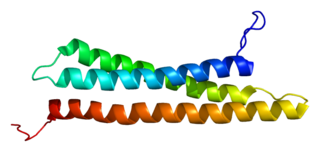Syntaxin 3, also known as STX3, is a protein [5] which in humans is encoded by the STX3 gene. [6] [7]
Syntaxin 3, also known as STX3, is a protein [5] which in humans is encoded by the STX3 gene. [6] [7]
The protein encoded by this gene is a member of the syntaxin family of cellular receptors for transport vesicles which participate in exocytosis in neutrophils. [6] STX3 has an important role in the growth of neurites and serves as a direct target for omega-6 arachidonic acid. [8] Mutations in Syntaxin 3 cause Microvillus inclusion disease. [9]
Syntaxin 3 has been shown to interact with SNAP-25, [10] [11] [12] SNAP23 [11] [12] [13] [14] and SNAP29. [12]

Synaptosomal-Associated Protein, 25kDa (SNAP-25) is a Target Soluble NSF (N-ethylmaleimide-sensitive factor) Attachment Protein Receptor (t-SNARE) protein encoded by the SNAP25 gene found on chromosome 20p12.2 in humans. SNAP-25 is a component of the trans-SNARE complex, which accounts for membrane fusion specificity and directly executes fusion by forming a tight complex that brings the synaptic vesicle and plasma membranes together.

Syntaxin-1A is a protein that in humans is encoded by the STX1A gene.

Synaptosomal-associated protein 23 is a protein that in humans is encoded by the SNAP23 gene. Two alternative transcript variants encoding different protein isoforms have been described for this gene.

Syntaxin-4 is a protein that in humans is encoded by the STX4 gene.

Vesicle-associated membrane protein 2 (VAMP2) is a protein that in humans is encoded by the VAMP2 gene.

Syntaxin-binding protein 1 is a protein that in humans is encoded by the STXBP1 gene. This gene encodes a syntaxin-binding protein. The encoded protein appears to play a role in release of neurotransmitters via regulation of syntaxin, a transmembrane attachment protein receptor. Mutations in this gene have been associated with neurological disorders including epilepsy, intellectual disability, and movement disorders.

Vesicle-associated membrane protein 7 (VAMP-7), is a protein that in humans is encoded by the VAMP7 gene also known as the or SYBL1 gene.

Syntaxin-7 is a protein that in humans is encoded by the STX7 gene.

N-ethylmaleimide-sensitive factor Attachment Protein Alpha, also known as SNAP-α, is a SNAP protein that is involved in the intra-cellular trafficking and fusing of vesicles to target membranes in cells.

Vesicle-associated membrane protein 3 is a protein that in humans is encoded by the VAMP3 gene.

Plakophilin-4 is a protein that in humans is encoded by the PKP4 gene.

Complexin-2 is a protein that in humans is encoded by the CPLX2 gene.

Syntaxin-2, also known as epimorphin, is a protein that in humans is encoded by the STX2 gene.

Syntaxin-12 is a protein that in humans is encoded by the STX12 gene.

Vesicle-associated membrane protein 8 is a protein that in humans is encoded by the VAMP8 gene.

Syntaxin-8 is a protein that in humans is encoded by the STX8 gene. Syntaxin 8 directly interacts with HECTd3 and has similar subcellular localization. The protein has been shown to form the SNARE complex with syntaxin 7, vti1b and endobrevin. These function as the machinery for the homotypic fusion of late endosomes.

Syntaxin-binding protein 2 is a protein that in humans is encoded by the STXBP2 gene.

Synaptosomal-associated protein 29 is a protein that in humans is encoded by the SNAP29 gene.
Munc-18 proteins are the mammalian homologue of UNC-18 and are a member of the Sec1/Munc18-like (SM) protein family. Munc-18 proteins have been identified as essential components of the synaptic vesicle fusion protein complex and are crucial for the regulated exocytosis of neurons and neuroendocrine cells.

Syntaxin 17 is a protein that in humans is encoded by the STX17 gene. In horses a duplication in intron 6 causes progressive graying.